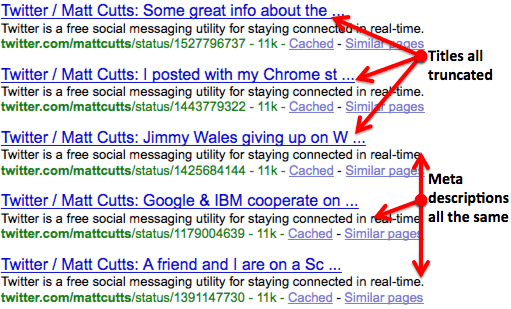Meta descriptions are an incredibly important (and often overlooked) element of the digital ecosystem.
A short paragraph of text that summarizes a page’s content, the meta description plays a vital role in getting searchers to click on your page, rather than your competitors’. Not only does the description serve as a “sneak peek” into the page’s content, but search engines will highlight the keywords that match with a given search in bold in order to grab the searcher’s attention.
Thankfully, meta descriptions are simple to add. The content of the text, however, can very easily become an afterthought. A neglected meta description is a seemingly harmless, yet surprisingly quick way to lose viewers, leads, and traffic in one fell swoop.
The Importance of Meta Descriptions
While click-throughs are important, a page’s reach goes beyond a single search engine query. Meta descriptions also appear when shared across different websites, as well as all social media channels. On the highly-competitive platforms such as Facebook and LinkedIn, a great description will help to reel in potential clicks.
How to Add a Meta Description
Depending on the website or server that you’re using, the location of the HTML section will vary. However, per the example below, it’s as easy as adding in your text where the code says “content=”.
<head>
<meta name=”description” content=”This is an example of a meta description. This will often show up in search results.”>
</head>
A variety of plugins like Yoast, for Wordpress, SEMrush, and Google Keywords planner are also available to anyone who needs an extra, helping hand with their SEO strategies.
Meta Description Length
With the limit of meta descriptions having been increased to 320 characters in late 2017, there now exists a little more wiggle room for content and keywords. The optimal length for any page will be relative to the page’s content, however, so don’t feel the need to fill the entire box of text. The rule of thumb is to keep the description between 50-300 characters, and to always keep your content relevant.
How to Write Effective Meta Descriptions
The goal of your text is to put your content above all the rest. Draft a list of evergreen keywords, as well as ones pertaining to specific parts of your brand to use – and to adjust – to each page. Here are a few more boxes to check off when it comes to putting together a proper meta description:
1. Create compelling copy
A compelling meta description draws the reader in with a call-to-action, or goal-oriented language. Whether it is an organic search, or a click gained through social media, your job is to direct their attention to your site; not only with coinciding keywords, but with language that provides an answer to their query.
This is a good example of how the character count can be used to maximum impact by asking a question, while also getting to the point.

And here is an example of a meta description that’s not so great. Avoid going over the character count so as not to get the dreaded ellipses at the end, cutting your thought in half.

In short, your meta description should invite a reader in with natural-sounding and appealing copy, as opposed to one that’s been “keyword-stuffed”—otherwise known as putting in as many keywords as possible with the hope of a higher rank, regardless if they make sense or not.
2. Avoid duplicate meta tags
While this is not exactly a requirement, creating a variety of descriptions for each of your pages is a mode of best practice. While sites like Wordpress will notify you when your meta description is lacking in some way, shape, or form, Google dislikes when descriptions are copied and pasted. While you won’t be penalized for by the search engine for having duplicate meta descriptions, a repeated description limits your chances of having multiple pages rank high. See an example from Wordpress below.

3. Don’t add double quotation marks
When superfluous quotation marks (“quotes”) are added, Google will cut off the description when it appears on a SERP. The best practice is to keep only letters and numbers in your meta descriptions. However, if quotations marks need to be mentioned per the content of your page, you can use the HTML entity rather than double quotes to avoid cutting off the text.
Meta description writing is an easy practice that can easily be put on the backburner.
When you feel at a loss, put yourself in the shoes of your searcher. What keywords would you search for when looking for your page? What copy would be the most attention-grabbing? Remember: compelling copy goes a long way, especially with a limited character count. Work on those meta descriptions, and watch your click-through rate soar.
For more tips on how to rank higher in SERPs, see here.
Don’t forget to share this article


